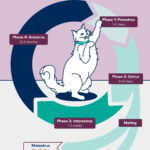Navigating the world of cat food can be confusing, especially when you’re aiming for the best nutrition for your feline friend. Many cat owners are now turning to Natural Cat Food options, seeking healthier and more species-appropriate diets. To help you understand what natural cat food entails, we’ve compiled some frequently asked questions.
Decoding “Meal Free” in Natural Cat Food
Q. What does “meal free” really mean in natural cat food?
When you see “meal free” on a natural cat food label, it signifies a commitment to using high-quality, whole protein sources. Unlike conventional cat foods that often include rendered meats known as ‘meals’ (like chicken meal, turkey meal, or fish meal), meal-free recipes utilize dehydrated whole meats. For example, RAWZ natural cat food uses dehydrated chicken, real poultry, and wild-caught fish. This emphasis on whole meats provides a more natural and digestible protein source for your cat, mirroring their ancestral diet.
The Role of Carbohydrates in a Natural Cat Diet
Q. Why are lower carbohydrates considered better in natural cat food?
Cats are obligate carnivores, meaning their bodies are biologically designed to thrive on a diet primarily composed of meat. In their natural environment, carbohydrates play a minimal role in their diet. Therefore, carbohydrates are not considered essential nutrients for cats in any quantity. In fact, a diet high in carbohydrates can be detrimental to feline health, potentially leading to weight gain and other health issues. Natural cat foods often prioritize lower carbohydrate content to better align with a cat’s nutritional needs, focusing instead on protein and healthy fats.
Natural Cat Food for All Life Stages
Q. Can natural cat food truly support all life stages and breeds of cats?
Yes, high-quality natural cat foods can be formulated to meet the nutritional needs of cats at every stage of life, from kittens to seniors, and across all breeds. To be labeled as “all life stages” by the Association of American Feed Control Officials (AAFCO), a cat food must undergo rigorous testing to ensure it provides complete and balanced nutrition for gestation/lactation, growth, adult maintenance, and all life stages. RAWZ meal-free dry recipes and pâtés, for example, meet these stringent AAFCO guidelines. While their shredded cans and pouches are formulated for adult maintenance, all RAWZ packaging includes clear feeding instructions to guide you in providing the appropriate amount based on your cat’s weight and age.
Transitioning to Natural Cat Food
Q. How do I smoothly transition my cat to a natural cat food like RAWZ?
A gradual transition is key to avoid digestive upset when introducing any new cat food, including natural options. Over a period of 5 to 7 days, slowly incorporate RAWZ into your cat’s current food. Begin by mixing in a small amount of RAWZ and gradually increase the proportion each day, while decreasing the amount of the old food. By day 7, your cat should be eating 100% RAWZ.
During the transition, monitor your cat’s stool. A healthy transition and diet should result in stools that are well-formed but soft, not too hard or too loose. If you notice any digestive issues like diarrhea, slow down the transition process and consult with a veterinarian or a veterinary nutritionist for personalized guidance. Remember to follow general guidelines for transitioning cat food and always prioritize your cat’s well-being.
Switching to a natural cat food can be a significant step towards improving your cat’s health and well-being, offering them a diet that is closer to their natural dietary needs.

